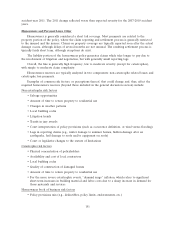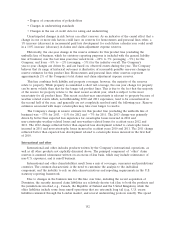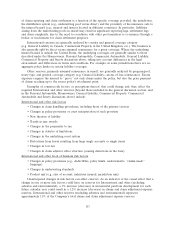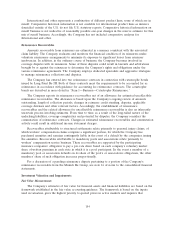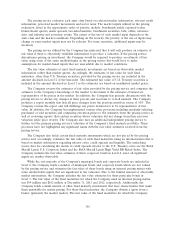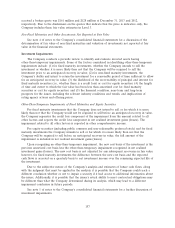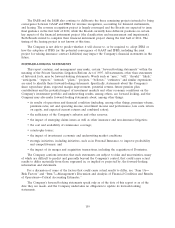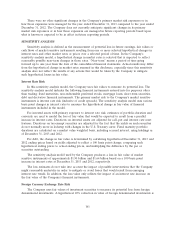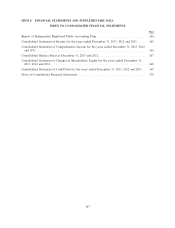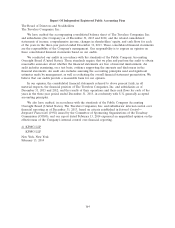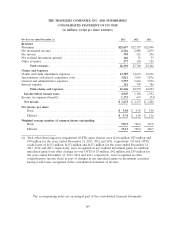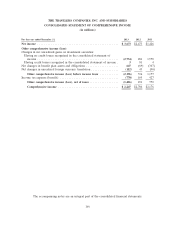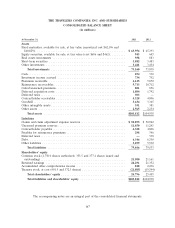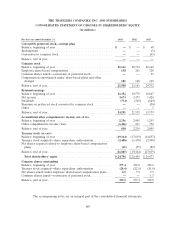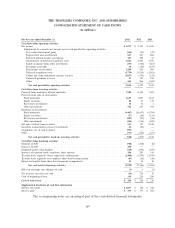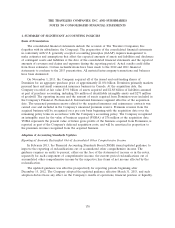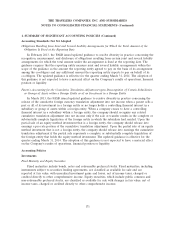Travelers 2013 Annual Report Download - page 171
Download and view the complete annual report
Please find page 171 of the 2013 Travelers annual report below. You can navigate through the pages in the report by either clicking on the pages listed below, or by using the keyword search tool below to find specific information within the annual report.There were no other significant changes in the Company’s primary market risk exposures or in
how those exposures were managed for the year ended December 31, 2013 compared to the year ended
December 31, 2012. The Company does not currently anticipate significant changes in its primary
market risk exposures or in how those exposures are managed in future reporting periods based upon
what is known or expected to be in effect in future reporting periods.
SENSITIVITY ANALYSIS
Sensitivity analysis is defined as the measurement of potential loss in future earnings, fair values or
cash flows of market sensitive instruments resulting from one or more selected hypothetical changes in
interest rates and other market rates or prices over a selected period of time. In the Company’s
sensitivity analysis model, a hypothetical change in market rates is selected that is expected to reflect
reasonably possible near-term changes in those rates. ‘‘Near-term’’ means a period of time going
forward up to one year from the date of the consolidated financial statements. Actual results may differ
from the hypothetical change in market rates assumed in this disclosure, especially since this sensitivity
analysis does not reflect the results of any actions that would be taken by the Company to mitigate
such hypothetical losses in fair value.
Interest Rate Risk
In this sensitivity analysis model, the Company uses fair values to measure its potential loss. The
sensitivity analysis model includes the following financial instruments entered into for purposes other
than trading: fixed maturities, non-redeemable preferred stocks, mortgage loans, short-term securities,
debt and derivative financial instruments. The primary market risk to the Company’s market sensitive
instruments is interest rate risk (inclusive of credit spreads). The sensitivity analysis model uses various
basis point changes in interest rates to measure the hypothetical change in fair value of financial
instruments included in the model.
For invested assets with primary exposure to interest rate risk, estimates of portfolio duration and
convexity are used to model the loss of fair value that would be expected to result from a parallel
increase in interest rates. Durations on invested assets are adjusted for call, put and interest rate reset
features. Durations on tax-exempt securities are adjusted for the fact that the yields on such securities
do not normally move in lockstep with changes in the U.S. Treasury curve. Fixed maturity portfolio
durations are calculated on a market value weighted basis, including accrued interest, using holdings as
of December 31, 2013 and 2012.
For debt, the change in fair value is determined by calculating hypothetical December 31, 2013 and
2012 ending prices based on yields adjusted to reflect a 100 basis point change, comparing such
hypothetical ending prices to actual ending prices, and multiplying the difference by the par or
securities outstanding.
The sensitivity analysis model used by the Company produces a loss in fair value of market
sensitive instruments of approximately $1.90 billion and $1.64 billion based on a 100 basis point
increase in interest rates at December 31, 2013 and 2012, respectively.
The loss estimates do not take into account the impact of possible interventions that the Company
might reasonably undertake in order to mitigate or avoid losses that would result from emerging
interest rate trends. In addition, the loss value only reflects the impact of an interest rate increase on
the fair value of the Company’s financial instruments.
Foreign Currency Exchange Rate Risk
The Company uses fair values of investment securities to measure its potential loss from foreign
denominated investments. A hypothetical 10% reduction in value of foreign denominated investments is
161


